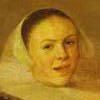.

Kathe Kollwitz 1867-1945 German Artist Kathe Kollwitz concentrated mostly on etchings depicting the beauty, dignity, and fighting spirit of oppressed people. Her most important works are two series of etchings: 'Revolt of the Weavers' and 'The Peasant War'. After the death of her son in battle in 1914 the mother protecting her children became the central theme of her work.
She also
sculpted a granit monument depicting grieving parents which serves still as a monument to the
slain youth of all nations.
At first she lived with her husband in his estate but decided later to return to Paris where she formed a literary circle and began to write.
Madame de La Fayette's
first novel was published anonymously, her second under a different name, and her masterpiece
'La Princess de Cleves' again anonymously. Its dignified dialogue and psycholo-gical
insights opened a new era in the history of the novel
She also wrote 'Jerusalem' concerning Swedish farmers who
emigrated to Palestine, but she is most known for the children's classic
'The Wonderful Adventures of Nils' about a little boy who flies around Sweden on a geese.
Nobel Prize 1909
Many of her genre scenes of everyday
Dutch life hang in the leading museums of Europe. Her painting 'The Jolly Toper' was
attributed to Franz Hals until her monogram was revealed during cleaning.
|


